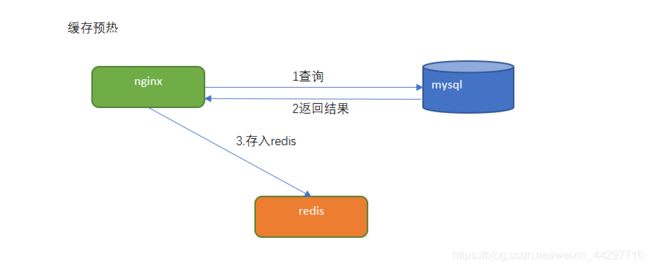nginx(OpenResty)+lua+redis实现缓存预热或二级缓存查询
nginx(OpenResty)+lua+redis实现缓存预热或二级缓存查询
在电商项目中可以用来处理广告的缓存
一丶实现缓存预热
实现思路:
定义请求:用于查询数据库中的数据更新到redis中。
(1)连接mysql ,按照广告分类ID读取广告列表,转换为json字符串。
(2)连接redis,将广告列表json字符串存入redis 。
定义请求:
请求:
/ad_update
参数:
position --指定广告位置
返回值:
json
在/root/lua目录下创建ad_load.lua ,实现连接mysql 查询数据 并存储到redis中。
ngx.header.content_type="application/json;charset=utf8"
local cjson = require("cjson")
local mysql = require("resty.mysql")
local uri_args = ngx.req.get_uri_args()
local position = uri_args["position"]
local db = mysql:new()
db:set_timeout(1000)
local props = {
host = "192.168.200.128",
port = 3306,
database = "changgou_business",
user = "root",
password = "root"
}
local res = db:connect(props)
local select_sql = "select url,image from tb_ad where status ='1' and position='"..position.."' and start_time<= NOW() "
res = db:query(select_sql)
db:close()
local redis = require("resty.redis")
local red = redis:new()
red:set_timeout(2000)
local ip ="192.168.200.128"
local port = 6379
red:connect(ip,port)
red:set("ad_"..position,cjson.encode(res))
red:close()
ngx.say("{flag:true}")
修改/usr/local/openresty/nginx/conf/nginx.conf文件:
代码如下:
#user nobody;
user root root;
worker_processes 1;
#error_log logs/error.log;
#error_log logs/error.log notice;
#error_log logs/error.log info;
#pid logs/nginx.pid;
events {
worker_connections 1024;
}
http {
include mime.types;
default_type application/octet-stream;
sendfile on;
#tcp_nopush on;
#keepalive_timeout 0;
keepalive_timeout 65;
#gzip on;
server {
listen 80;
server_name localhost;
charset utf-8;
#access_log logs/host.access.log main;
# 添加
location /ad_update {
content_by_lua_file /root/lua/ad_update.lua;
}
# redirect server error pages to the static page /50x.html
#
error_page 500 502 503 504 /50x.html;
location = /50x.html {
root html;
}
}
}
重新启动nginx 在nginx的sbin目录下
./nginx -s reload
测试:http://192.168.200.128/ad_update?position=web_index_lb
二丶广告缓存读取
实现思路:
通过lua脚本直接从redis中获取数据即可。
定义请求:
请求:/ad_read
参数:position
返回值:json
在/root/lua目录下创建ad_read.lua
ngx.header.content_type="application/json;charset=utf8"
local uri_args = ngx.req.get_uri_args();
local position = uri_args["position"];
local redis = require("resty.redis");
local red = redis:new()
red:set_timeout(2000)
local ok, err = red:connect("192.168.200.128", 6379)
local rescontent=red:get("ad_"..position)
ngx.say(rescontent)
red:close()
在/usr/local/openresty/nginx/conf/nginx.conf中server下添加配置
location /ad_read {
content_by_lua_file /root/lua/ad_read.lua;
}
测试 http://192.168.200.128/ad_read?position=web_index_lb 输出
[{"url":"img\/banner1.jpg","image":"img\/banner1.jpg"},{"url":"img\/banner2.jpg","image":"img\/banner2.jpg"}]
三丶 二级缓存-加入openresty本地缓存
如上的方式没有问题,但是如果请求都到redis,redis压力也很大,所以我们一般采用多级缓存的方式来减少下游系统的服务压力。
先查询openresty本地缓存 如果没有再查询redis中的数据
- 修改/root/lua目录下ad_read文件, 内容如下:
ngx.header.content_type="application/json;charset=utf8"
local uri_args = ngx.req.get_uri_args();
local position = uri_args["position"];
local cache_ngx = ngx.shared.dis_cache;
local adCache = cache_ngx:get('ad_cache_'..position);
if adCache == "" or adCache == nil then
local redis = require("resty.redis");
local red = redis:new()
red:set_timeout(2000)
local ok, err = red:connect("192.168.200.128", 6379)
local rescontent=red:get("ad_"..position)
ngx.say(rescontent)
red:close()
cache_ngx:set('ad_cache_'..position, rescontent, 10*60);
else
ngx.say(adCache)
end
- 修改nginx配置文件vi /usr/local/openresty/nginx/conf/nginx.conf ,http节点下添加配置:
#包含redis初始化模块
lua_shared_dict dis_cache 5m; #共享内存开启

